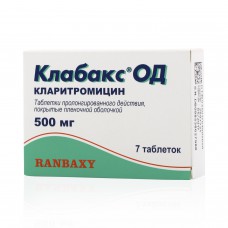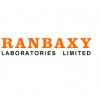Expiration date: 02/2026
The composition and form of issue:
Tablets prolonged action, film-coated. 1 tabket contains:
clarithromycin 500 mg
excipients: hypromellose lactose monohydrate microcrystalline povidone silica colloidal anhydrous sodium fumarate talc magnesium stearate
film coating: Opadry yellow colorant 20H52875 (hypromellose, propylene glycol, vanillin, titanium dioxide, hyprolose, talc, colorant quinoline yellow 18-24 %)
ink composition: black ink Opacode-S-1-17734 (shellac 45% (20% esterified) in SD-45 alcohol, iron dye oxide black, n-butanol, propylene glycol, methanol, isopropanol*, ammonium hydroxide 28%)
* evaporates during the production process
in blistere 5 or 7 pieces in the stack cartons 1 or 2 blisters.
Description of dosage form:
Oval, biconvex light yellow film-coated tablets printed in black "CLNHL" ink on one side.
Pharmacokinetics:
Clarithromycin is metabolized in the cytochrome p4503a (CYP3A) liver. The absolute bioavailability is about 50%. With repeated administration of the drug cumulation is not found and the nature of metabolism in the human body does not change.
Clarithromycin binds with plasma proteins up to 70% at a concentration of from 0, 45 to 4, 5 µg/ml. At a concentration of 45 mcg/ml binding is reduced to 41%, likely the result of saturation of the bonding. This is observed only at concentrations that are many times higher than therapeutic.
The clarithromycin prolonged action oral dose of 500 mg per day allows you to maintain steady-state levels of maximum concentrations of clarithromycin and 14-hydroxyclarithromycin in blood plasma. Equilibrium Cmax clarithromycin and 14-hydroxyclarithromycin in plasma are 1, 3 and 0, 48 µg/ml, respectively. T1/2 of the original drug and its main metabolite are respectively 5, 3 and 7, 7 PM In the clarithromycin prolonged action oral dose of 1000 mg per day (2 table. 500 mg) steady-state levels of Cmax of clarithromycin and 14-hydroxyclarithromycin, on average, 2.4 and 0, 67 µg/ml, respectively. T1/2 of the original drug and its main metabolite are respectively 5, 8 and 8, 9 including the Value of Tmax when taking doses of 500 and 1000 mg per day is approximately 6 hours In steady state level 14-hydroxyclarithromycin not increase proportionally with doses of clarithromycin, and T1/2 of clarithromycin and its main metabolite increase with increasing doses. The nonlinear nature of clarithromycin pharmacokinetics is associated with a decrease in the formation of 14-hydroxylated and N-demethylated metabolites at higher doses, which indicates the nonlinearity of clarithromycin metabolism at high doses.
With urine, about 40% of the dose of clarithromycin is released, through the intestine — about 30%.
Clarithromycin and 14-hydroxyclarithromycin are widely distributed in tissues and body fluids. After oral administration of clarithromycin content in cerebrospinal fluid is low (if normal BBB permeability of 1-2% of the level in the blood serum). The content in tissues is usually several times higher than in serum.
Disorders of liver function. In patients with moderate and severe impairment of liver function, but with preserved renal function, clarithromycin dose adjustment is not required. The equilibrium concentration in blood plasma and systemic clearance of clarithromycin does not differ in patients of this group and healthy patients. The equilibrium concentration level of 14-hydroxyclarithromycin in people with impaired liver function is lower than in healthy people.
The impairment of renal function. In violation of kidney function increases the minimum and maximum content of clarithromycin in blood plasma, T1/2, AUC clarithromycin and 14-hydroxyclarithromycin. The constant of elimination and the urinary excretion reduced. The degree of change in these parameters depends on the degree of renal impairment.
Patients of advanced age. In elderly patients, the level of clarithromycin and 14-hydroxyclarithromycin in the blood was higher, and the excretion is slower than in a group of young people. It is believed that changes in pharmacokinetics in elderly patients are associated primarily with changes in creatinine clearance and functional state of the kidneys, rather than with the age of patients.
Description of the pharmacological action:
Macrolide bacteriostatic antibiotic of the second generation from the group of broad-spectrum macrolides. Violates the protein synthesis of microorganisms (binds with 50S subunit of ribosome membrane of microbial cells).
Active against: Streptococcus agalactiae (Streptococcus pyogenes, Streptococcus viridans, Streptococcus pneumoniae), Haemophilus influenzae (parainfluenzae), Haemophilus ducreyi, Neisseria gonorrhoeae, Neisseria meningitidis, Listeria monocytogenes, Legionella pneumophila, Mycoplasma pneumoniae, Helicobacter (Campylobacter) pylori, Campylobacter jejuni, chlamydia pneumoniae (trachomatis), Moraxella (Branhamella) catarrhalis, Bordetella pertussis, Propionibacterium acnes, Staphylococcus aureus, Ureaplasma urealyticum, Toxoplasma gondii, Corynebacterium spp., Borrelia burgdorferi, Treponema pallidum, Pasteurella multocida, some anaerobes (Eubacterium spp., Peptococcus spp., Propionibacterium spp., Clostridium perfringens, Bacteroides melaninogenicus) and all mycobacteria except M. tuberculosis.
The main metabolite of clarithromycin in the human body is microbiologically active metabolite 14-hydroxyclarithromycin. Microbiological activity of the metabolite is the same as that of the initial substance, or 1-2 times weaker in relation to most microorganisms. The exception is H. influenzae, in respect of which the efficiency of the metabolite is 2 times higher. The starting substance and its main metabolite have either an additive or synergistic effect with respect to H. influenzae in vitro and in vivo, depending on the culture of bacteria.
Indications:
Treatment of infectious diseases caused by sensitive microorganisms:
- infections of the lower respiratory tract (bronchitis, pneumonia)
- upper respiratory tract infections (pharyngitis, sinusitis), otitis
- infections of the skin and soft tissues (folliculitis, erysipelas)
- common or localized mycobacterial infections caused by Mycobacterium avium and Mycobacterium intracellulare. Localized infections caused by Mycobacterium chelonae, Mycobacterium fortuitum and Mycobacterium kansasii.
- elimination of H. pylori and reduction of duodenal ulcer recurrence rate associated with H. pylori.
Contraindications:
- hypersensitivity to antibiotics from the group of macrolides
- working with derivatives of ergot
- sharing with cisapride, pimozide, astemizole and terfenadine (see also section "Interactions"). In patients taking these drugs simultaneously with clarithromycin, there is an increase in their concentration in the blood. With the possible prolongation of the QT interval and the development of cardiac arrhythmias, including paroxysmal ventricular tachycardia, ventricular fibrillation and flutter or fibrillation of the ventricles
- severe violations of the liver and/or kidney (Cl creatinine less than 30 ml/min)
- porphyria
- children under 12 years of age (only for this dosage form).
Application during pregnancy and breast-feeding:
The safety of clarithromycin during pregnancy and breastfeeding has not been established. Therefore, during pregnancy clarithromycin is prescribed only in the absence of alternative therapy, if the intended benefit exceeds the possible risk to the fetus.
Clarithromycin penetrates into the female milk, so if necessary, its use during lactation breast-feeding should be stopped.
Side effect:
Most often there are complaints from the digestive tract (nausea, dyspepsia, abdominal pain, vomiting and diarrhea). There are reports of the development of pseudomembranous colitis from moderate to life-threatening. Other adverse reactions include headaches, disturbance of taste and transient increased activity of liver enzymes.
There are reports of rare cases of paresthesia, as well as hepatitis with an increase in liver enzymes in the blood and the development of cholestasis and jaundice, which in some cases was severe, but usually reversible. In exceptional cases, there was liver failure with a fatal outcome.
It is known about rare cases of increasing the concentration of creatinine in serum, the development of interstitial nephritis, the development of renal failure.
When taking clarithromycin, allergic reactions were observed, the intensity of which varied from urticaria and skin rash to anaphylaxis and Stevens-Johnson syndrome.
There are reports of hearing loss during treatment with clarithromycin, which is in most cases recovered after discontinuation of the drug. There may be a taste disorder.
There is evidence of the development of glossitis, stomatitis, candidiasis of the oral mucosa and changing the color of the tongue during treatment with clarithromycin. It is also reported that in most cases the reversible change in tooth color in patients receiving clarithromycin.
In rare cases, there was hypoglycemia in a number of these cases, hypoglycemia developed in patients who took during treatment with clarithromycin hypoglycemic agents for oral administration or insulin.
Individual cases of thrombocytopenia and leukopenia are reported.
When taking clarithromycin, there was a transient side effect on the Central nervous system: dizziness, anxiety, fear, insomnia, nightmares, tinnitus, confusion, hallucinations, psychoses and depersonalization.
In the treatment of clarithromycin, as with other macrolides, very rarely observed elongation of THE Qt interval, ventricular arrhythmia, including ventricular paroxysmal tachycardia and trembling or flickering of the ventricles.
Drug interaction:
While admission increases the blood concentration of drugs metabolized in the liver by enzymes of the cytochrome P450 indirect anticoagulants, carbamazepine, theophylline, astemizola, cisapride, of terfenadine (2-3 times), triazolama, midazolam, cyclosporine, disopyramide, phenytoin, rifabutin, lovastatin, digoxin, ergot alkaloids etc.
Rare cases of acute necrosis of skeletal muscles are reported to coincide with the simultaneous administration of clarithromycin and hydroxymethylglutaryl-COA reductase inhibitors lovastatin and simvastatin.
There are reports of an increase in the concentration of digoxin in plasma in patients receiving both digoxin and clarithromycin tablets. In such patients, it is necessary to constantly monitor the content of digoxin in the serum to avoid digitalis intoxication.
Clarithromycin can reduce the clearance of triazolam and thus increase its pharmacological effects with the development of drowsiness and confusion of consciousness.
The simultaneous use of clarithromycin and ergotamine (ergot derivatives) can lead to acute ergotamine intoxication, manifested by severe peripheral vasospasm.
Co-administration to HIV-infected adults, zidovudine tablets and oral clarithromycin may lead to decrease of equilibrium concentration of zidovudine. Given that clarithromycin is likely to alter the absorption of oral administration simultaneously with zidovudine, this interaction is largely avoided when taking clarithromycin and zidovudine at different times of the day (at intervals of at least 4 hours).
When concomitant administration of clarithromycin and ritonavir increases the values of serum concentrations of clarithromycin. Dose adjustment of clarithromycin in these cases, in patients with normal renal function is not required. However, in patients with Cl creatinine from 30 to 60 ml/min clarithromycin dose should be reduced by 50%, and with Cl creatinine less than 30 ml / min should not appoint clarithromycin tablets prolonged action. Such patients are assigned a rapid-release clarithromycin 250 or 500 mg. While treatment with ritonavir should not be administered clarithromycin at doses above 1 g/day.
Method of application and doses:
Inside, during meals, without breaking, not chewing, swallowing whole.
Adults and children over 12 years of age — usually 500 mg once a day. In severe cases, the dose is increased to 500 mg 2 times a day.
Duration of treatment is 7-14 days.
For patients with Cl creatinine 30-60 ml / min only in severe infections may be administered at a dose of 500 mg 1 time per day (ie, reducing the daily dose of 50%).
Overdose:
Symptoms: probably the development of symptoms from the digestive tract (nausea, vomiting, diarrhea) headache, confusion.
Treatment: immediate gastric lavage and symptomatic treatment. Hemodialysis and peritoneal dialysis do not lead to a significant change in serum clarithromycin levels.
Special instruction:
In the presence of chronic liver diseases, it is necessary to conduct regular monitoring of serum enzymes.
With caution, prescribed against drugs metabolized by the liver (it is recommended to measure their concentration in the blood).
In the case of a joint appointment with warfarin or other indirect anticoagulants must be controlled PV.
Attention should be paid to the possibility of cross-resistance between clarithromycin and other antibiotics from the macrolide group, as well as lincomycin and clindamycin.
With prolonged or repeated use of the drug may develop superinfection (re-infection with the same pathogens on the background of the developed disease).
Children up to 12 years it is recommended to apply Klabax in the form of granules for preparation of suspension for oral administration, 125 or 250 mg/5 ml.



